
Security News
Oracle Drags Its Feet in the JavaScript Trademark Dispute
Oracle seeks to dismiss fraud claims in the JavaScript trademark dispute, delaying the case and avoiding questions about its right to the name.
@andris/emailengine
Advanced tools
Headless email client that makes IMAP and SMTP resources available over REST. Integrate email accounts with your service with ease!
EmailEngine was previously known as IMAP API
$ npm install -g @andris/emailengine
$ emailengine
Tip For human readable logs you can use pino-pretty (
npm install -g pino-pretty) by piping EmailEngine output to it:emailengine | pino-pretty
This video shows how to
NB! Try to keep the latency between EmailEngine and Redis as low as possible, best if these would run in the same machine or at least in the same DC. EmailEngine runs a separate Redis command for each message in a folder when syncing messages, so if the latency is not low then it takes a long time to sync a folder with a lot of messages,
| Configuration option | CLI argument | ENV value | Default |
|---|---|---|---|
| IMAP Worker count | --workers.imap=4 | EENGINE_WORKERS=4 | 4 |
| Redis connection URL | --dbs.redis="url" | EENGINE_REDIS="url" | "redis://127.0.0.1:6379/8" |
| Host to bind to | --api.host="1.2.3.4" | EENGINE_HOST="1.2.3.4" | "127.0.0.1" |
| Port to bind to | --api.port=port | EENGINE_PORT=port | 3000 |
| Max attachment size | --api.maxSize=5M | EENGINE_MAX_SIZE=5M | 5M |
| Max command duration | --service.commandTimeout=10s | EENGINE_TIMEOUT=10s | 10s |
| Log level | --log.level="level" | EENGINE_LOG_LEVEL=level | "trace" |
| Prepared settings | --settings='{"JSON"}' | EENGINE_SETTINGS='{"JSON"}' | not set |
| Encryption secret | --service.secret="****" | EENGINE_SECRET="****" | not set |
| Local addresses | --service.localAddresses="ip1,ip2" | EENGINE_ADDRESSES="ip1,ip2" | default interface |
| API Basic Auth | --api.auth="user:pass" | EENGINE_AUTH="user:pass" | not set |
NB! environment variables override CLI arguments. CLI arguments override configuration file values.
If available then EmailEngine uses dotenv file from project root to populate environment variables.
$ emailengine --dbs.redis="redis://127.0.0.1:6379/8"
If you do not want to update application settings via API calls then you can provide the initial settings via a command line option (--settings) or environment variable (EENGINE_SETTINGS). The value must be a valid JSON string that could be used against the /settings API endpoint. The behavior is identical to calling the same thing via API, so whatever settings are given are stored in the DB.
$ emailengine --settings='{"webhooks": "https://webhook.site/14e88aea-3391-48b2-a4e6-7b617280155d","webhookEvents":["messageNew"]}'
If settings object fails validation then the application does not start.
By default account passwords are stored as cleartext in Redis. You can set an encryption secret that will be used to encrypt these passwords.
$ emailengine --service.secret="secret_encryption_key"
NB! Once you have selected an encryption key you have to continue using it
Secret key only applies to new accounts or account updates. To convert existing accounts into encrypted accounts or change the encryption key you can use the ecryption tool:
$ emailengine encrypt --service.secret="new_secret" --decrypt="old-secret"
This command encrypts all account passwords with "new_secret". If the account password was already encrypted then uses "old_secret" to decrypt the encrypted values before encrypting these with the new secret.
To disable encryption entirely run the tool without new encryption key:
$ emailengine encrypt --decrypt="old-secret"
If your server has multiple IP addresses/interfaces available then you can provide a comma separated list of these IP addresses for EmailEngine to bound to when making outbound connections.
This is mostly useful if you are making a large amount of connections and might get rate limited by destination server based on your IP address. Using multiple local addresses allows to distribute separate connections between separate IP addresses. An address is selected randomly from the list whenever making a new IMAP connection.
$ emailengine --service.localAddresses="192.168.1.176,192.168.1.177,192.168.1.178"
If those interfaces aren't actually available then TCP connections will fail, so check the logs.
Local addresses and SMTP
By default when EmailEngine is sending an email to SMTP it uses local hostname in the SMTP greeting. This hostname is resolved by os.hostname(). Sometimes hostname is using invalid format (eg. Servername_local as undersore is not actually allowed) and depending on the SMTP server it might reject such connection.
To overcome you can set the local hostname to use by appending the hostname to the IP address, separated by pipe symbol
$ emailengine --service.localAddresses="ip1|hostname1,ip2|hostname2,ip3|hostname3"
For example when using AWS you can use the private interface IP but set a public hostname.
$ emailengine --service.localAddresses="172.31.1.2|ec2-18-194-1-2.eu-central-1.compute.amazonaws.com"
So in general the hostname shoud be whatever the public interface IP (this is what the SMTP server sees) resolves to.
EmailEngine supports Basic Auth with a single user. This is a convenience option only, for any kind of production use you should implement your own user management and limit access with a firewall to trusted machines only.
$ emailengine --api.auth="user:password"
1. General overview
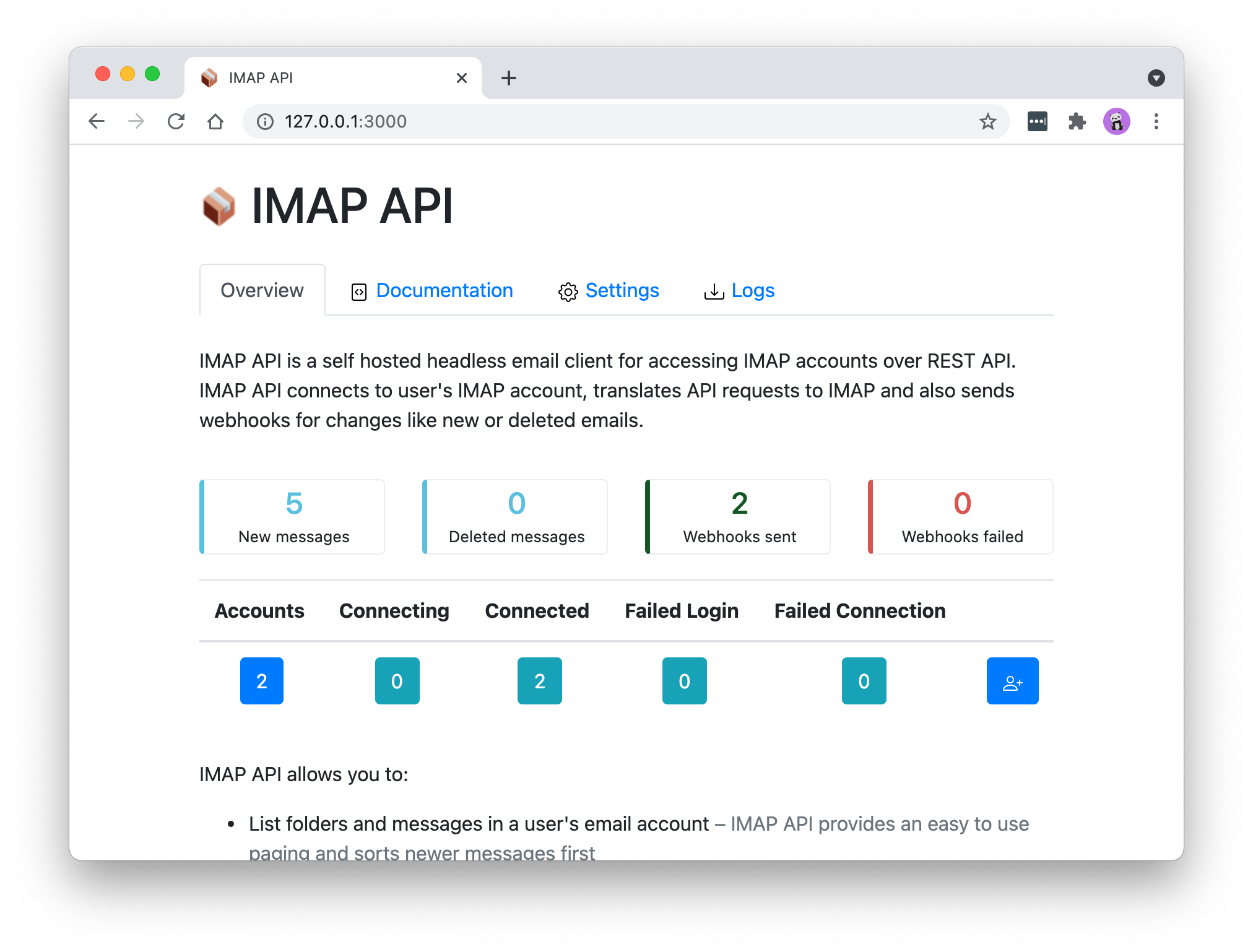
2. Account states
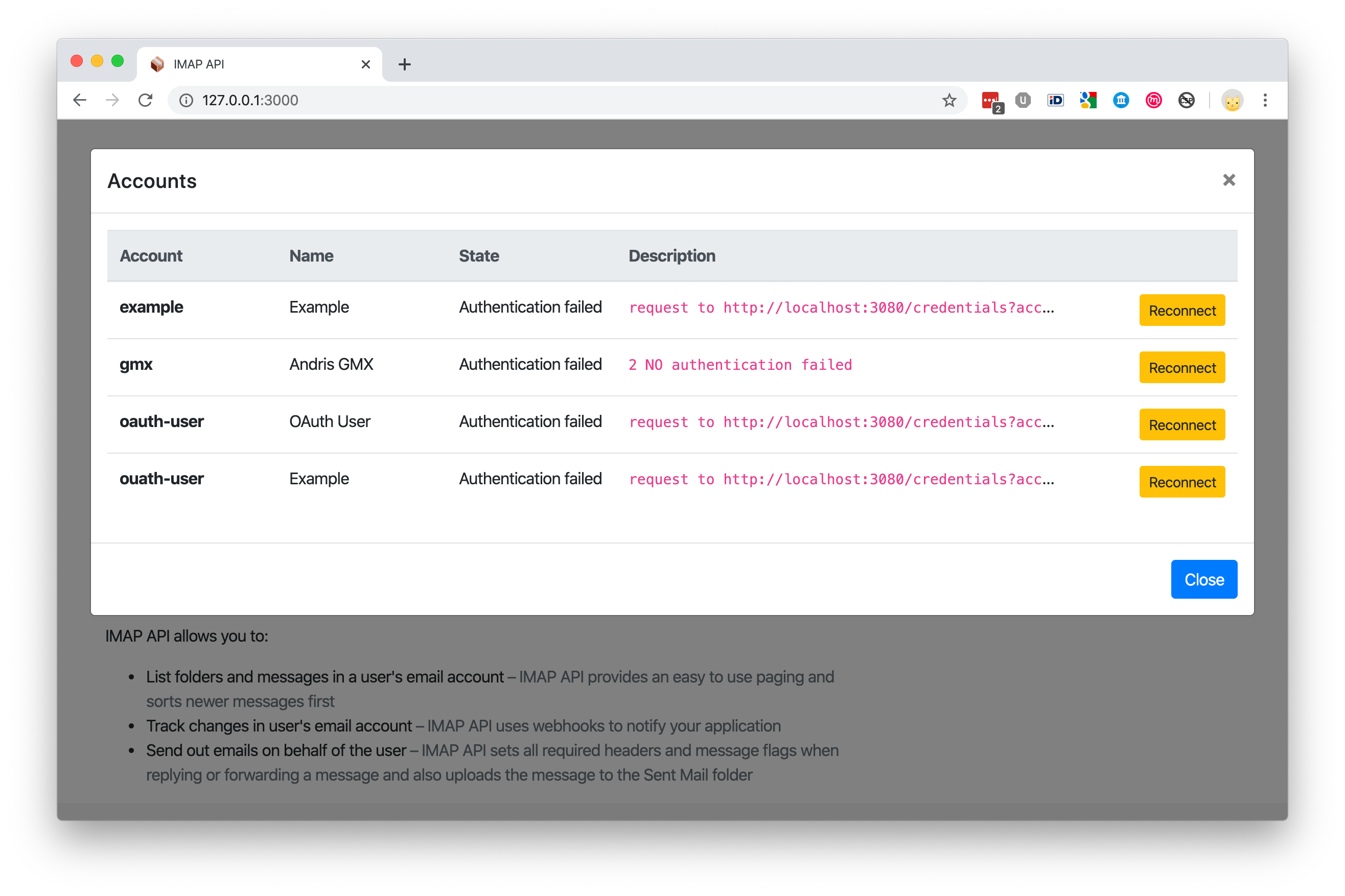
3. Documentation
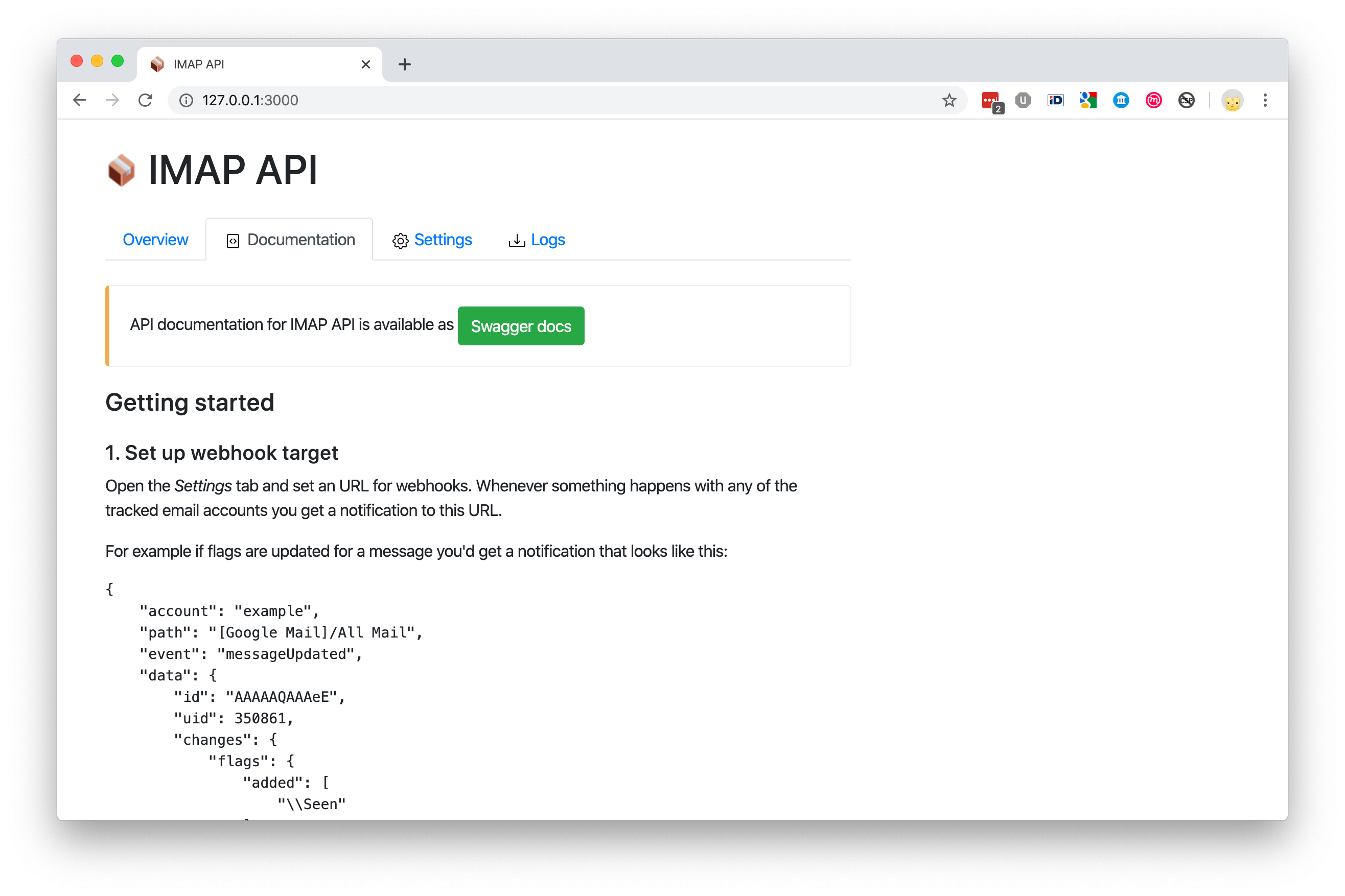
4. Settings
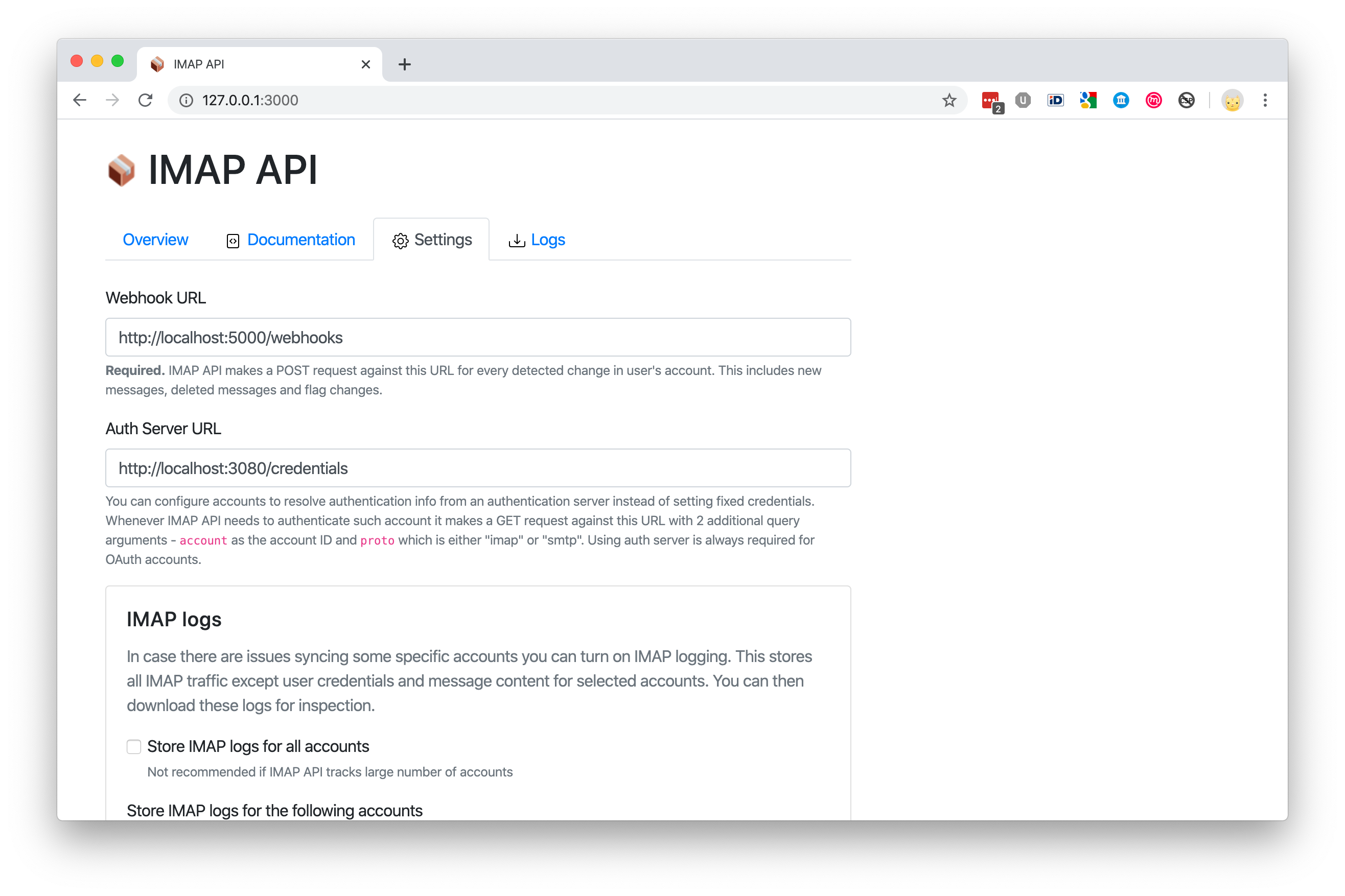
5. Download stored logs
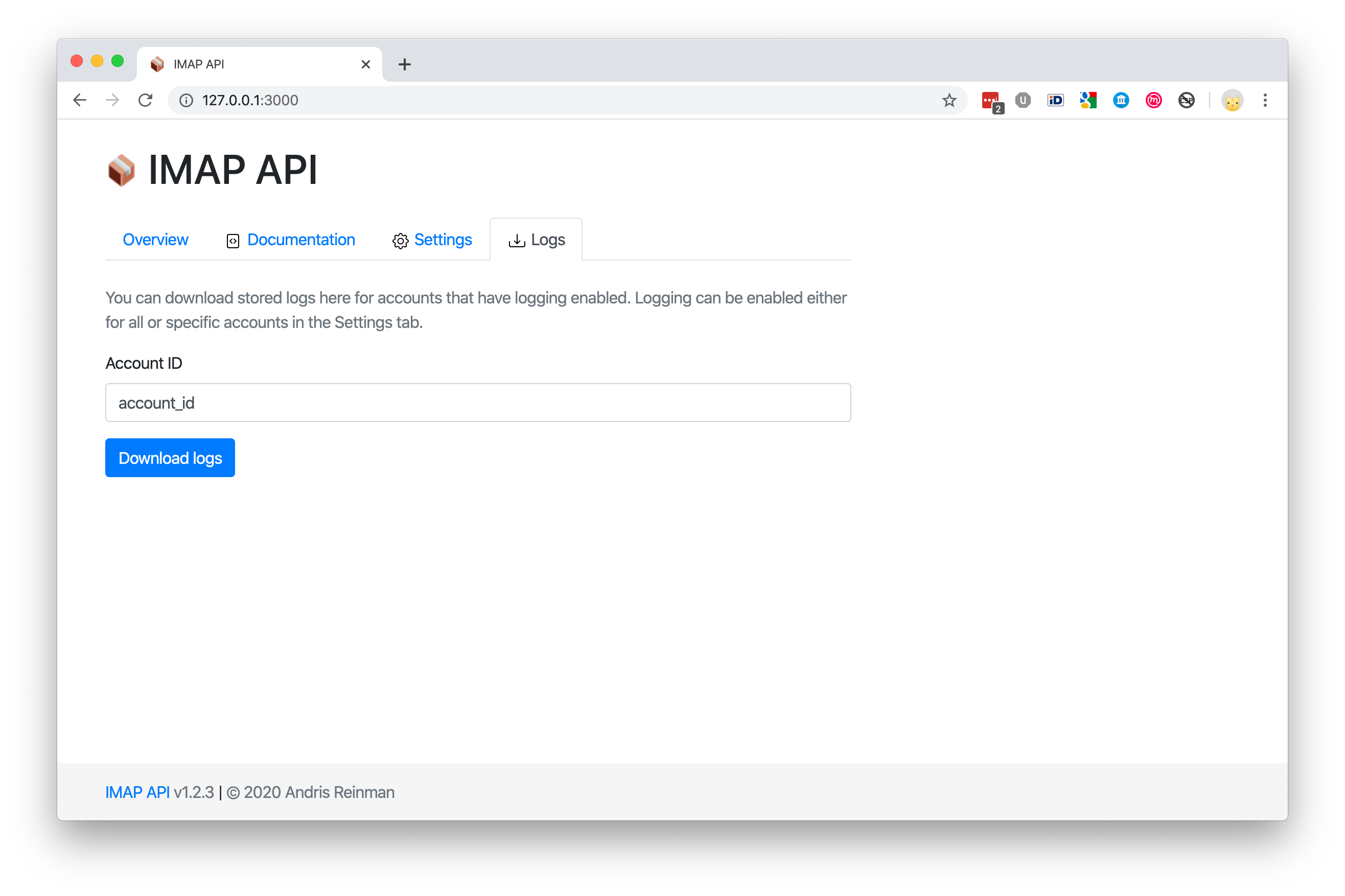
6. Swagger
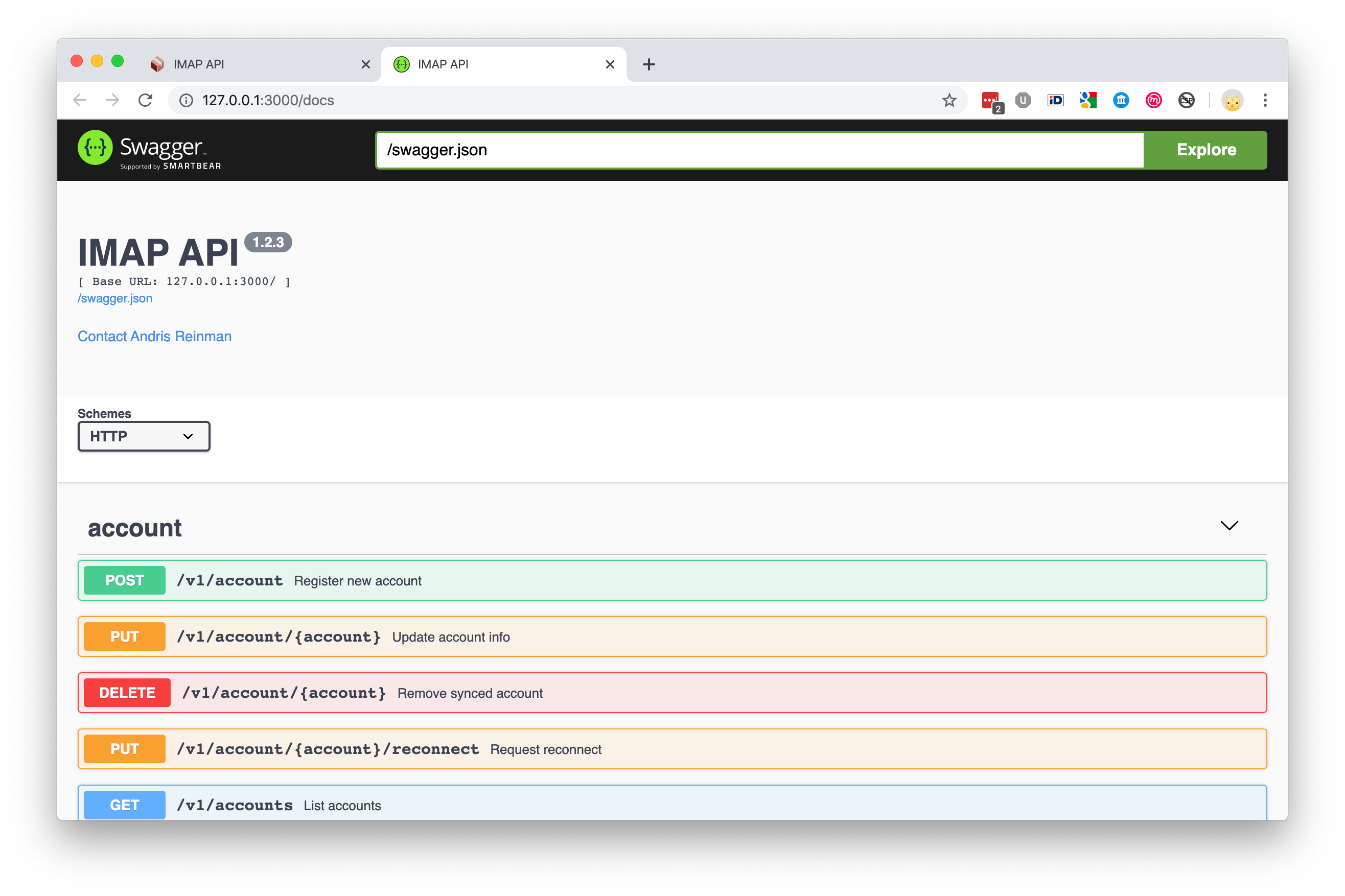
EmailEngine sends webhooks to a predefined URL whenever something happens on an account.
Easiest way to set it up would be to use the built in web interface. Open the Settings tab and set an URL for webhooks. You can also select specific events to listen for.
For example if flags are updated for a message you'd get a POST notification that looks like this:
{
"account": "example",
"path": "[Google Mail]/All Mail",
"event": "messageUpdated",
"data": {
"id": "AAAAAQAAAeE",
"uid": 350861,
"changes": {
"flags": {
"added": ["\\Seen"]
}
}
}
}
See the entire API Reference here
When registering a new account you have to provide an unique account ID for it. This could be any text identifer, even an email address.
NB! Trying to create a new account with the same ID updates the existing account.
$ curl -XPOST "localhost:3000/v1/account" -H "content-type: application/json" -d '{
"account": "example",
"name": "My Example Account",
"imap": {
"host": "imap.gmail.com",
"port": 993,
"secure": true,
"auth": {
"user": "myuser@gmail.com",
"pass": "verysecret"
}
},
"smtp": {
"host": "smtp.gmail.com",
"port": 465,
"secure": true,
"auth": {
"user": "myuser@gmail.com",
"pass": "verysecret"
}
}
}'
This example uses a Gmail account but in reality it might be difficult to get past Gmail's security restrictions. In this case use OAuth2 instead of password authentication.
EmailEngine returns paged results, newer messages first. So to get the first page or in other words the newest messages in a mailbox folder you can do it like this (notice the "example" id string that we set earlier in the request URL):
$ curl -XGET "localhost:3000/v1/account/example/messages?path=INBOX"
In the response you should see a listing of messages.
{
"page": 0,
"pages": 10,
"messages": [
{
"id": "AAAAAQAAAeE",
"uid": 481,
"date": "2019-10-07T06:05:23.000Z",
"size": 4334,
"subject": "Test message",
"from": {
"name": "Peter Põder",
"address": "Peter.Poder@example.com"
},
"to": [
{
"name": "",
"address": "andris@emailengine.app"
}
],
"messageId": "<0ebdd7b084794911b03986c827128f1b@example.com>",
"text": {
"id": "AAAAAQAAAeGTkaExkaEykA",
"encodedSize": {
"plain": 17,
"html": 2135
}
}
}
]
}
When fetching next page, add page query argument to the URL. Pages are zero indexes so if the server shows that there are 10 pages in total, it means you can query from page=0 to page=9. If you want longer pages, use pageSize query argument.
$ curl -XGET "localhost:3000/v1/account/example/messages?path=INBOX&page=5"
The following is an example of how to send a reply. In this case you should specify a reference message you are replying to (NB! this message must exist). Use the "id" from message listing as the "reference.message" value.
If referenced message was not found from the IMAP account then API responds with a 404 error and does not send out the reply.
curl -XPOST "localhost:3000/v1/account/example/submit" -H "content-type: application/json" -d '{
"reference": {
"message": "AAAAAQAAAeE",
"action": "reply"
},
"from": {
"name": "Example Sender",
"address": "sender@example.com"
},
"to": [{
"name": "Andris Reinman",
"address": "andris@emailengine.app"
}],
"text": "my reply to you",
"html": "<p>my reply to you</p>",
"attachments": [
{
"filename": "checkmark.png",
"content": "iVBORw0KGgoAAAANSUhEUgAAABAAAAAQAQMAAAAlPW0iAAAABlBMVEUAAAD///+l2Z/dAAAAM0lEQVR4nGP4/5/h/1+G/58ZDrAz3D/McH8yw83NDDeNGe4Ug9C9zwz3gVLMDA/A6P9/AFGGFyjOXZtQAAAAAElFTkSuQmCC"
}
]
}'
NB! if you are sending a standalone email then you most probably want to set subject value as well. For replies and forwards, EmailEngine sets subject itself, based on the referenced message.
When sending a referenced message:
\Answered flag to the referenced messageFor all messages:
copy: false option, then emails are not copied to Sent Mail folderRecommended approach for OAuth2 would be to manage access tokens outside of EmailEngine by running an authentication server. In this case whenever EmailEngine needs to authenticate an OAuth2 account, it makes a HTTP request to that authentication server. This server is responsible of respoding with a valid access token for EmailEngine to use.
You can find an example authentication server implementation from examples/auth-server.js.
Alternatively, for Gmail only, you can use EmailEngine as the OAuth2 handler. In this case you would have to provide OAuth2 client id and client secret to EmailEngine (see Oauth2 section in the Settings page) and then, when adding new accounts, use the Oauth2 option instead of manually specifying IMAP and SMTP settings.
In any case, your OAuth2 application for Gmail must support the following scope: "https://mail.google.com/".
Gmail requires security auditing if you are using restricted Oauth2 scopes for public accounts but for internal accounts (eg. accounts in your own GSuite organization) and test accounts (up to 100 pre-defined accounts) you do not need any permissions.
Instructions for setting up OAuth2 with EmailEngine can be found here.
useAuthServer:true flag for the account settings and not set auth valueaccount and proto, eg url?account=example&proto=imapRegister managed account
curl -XPOST "localhost:3000/v1/account" -H "content-type: application/json" -d '{
"account": "ouath-user",
"name": "Example",
"imap": {
"host": "imap.gmail.com",
"port": 993,
"secure": true,
"useAuthServer": true
},
"smtp": {
"host": "smtp.gmail.com",
"port": 465,
"secure": true,
"useAuthServer": true
}
}'
Auth server response for OAuth2 accounts:
{
"user": "username@gmail.com",
"accessToken": "jhdfgsjfmbsdmg"
}
Auth server response for password based accounts:
{
"user": "username@gmail.com",
"pass": "verysecret"
}
By default EmailEngine allows connections only from localhost. To change this either edit config file or use --api.host="0.0.0.0" cli option. This would enable outside access, so you should use firewall to only allow trusted sources.
See example systemd unit file ro run EmailEngine as a service and example Nginx config file to serve EmailEngine requests behind Nginx reverse proxy.
Pull EmailEngine from Docker Hub
$ docker pull andris9/emailengine
Run the app and provide connection URL to Redis (this example assumes that Redis is running in host machine):
$ docker run -p 3000:3000 --env CMD_ARGS="\
--dbs.redis=redis://host.docker.internal:6379/7 \
" \
andris9/emailengine
Next open http://127.0.0.1:3000 in your browser.
Clone this repo and in the root folder run the following to start both EmailEngine and Redis containers.
$ docker-compose up
Next open http://127.0.0.1:3000 in your browser.
There is a Prometheus output available at /metrics URL path of the app.
Changelog is available for Postal Systems subscribers here.
Licensed under GNU Affero General Public License v3.0 or later.
MIT-licensed version of EmailEngine is available for Postal Systems subscribers.
FAQs
Email Sync Engine
The npm package @andris/emailengine receives a total of 2 weekly downloads. As such, @andris/emailengine popularity was classified as not popular.
We found that @andris/emailengine demonstrated a not healthy version release cadence and project activity because the last version was released a year ago. It has 1 open source maintainer collaborating on the project.
Did you know?

Socket for GitHub automatically highlights issues in each pull request and monitors the health of all your open source dependencies. Discover the contents of your packages and block harmful activity before you install or update your dependencies.

Security News
Oracle seeks to dismiss fraud claims in the JavaScript trademark dispute, delaying the case and avoiding questions about its right to the name.

Security News
The Linux Foundation is warning open source developers that compliance with global sanctions is mandatory, highlighting legal risks and restrictions on contributions.

Security News
Maven Central now validates Sigstore signatures, making it easier for developers to verify the provenance of Java packages.